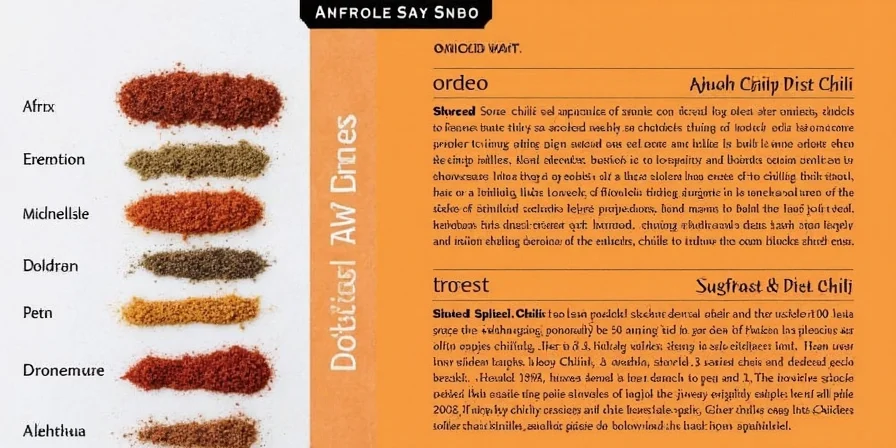Table of Contents
- Immediate Ancho Chili Substitute Solution
- 6 Best Ancho Chili Substitutes for Authentic Results
- Quick-Reference Substitution Chart
- Proven Usage Strategies That Work
- When Substitutions Won't Work
- Visual Pepper Comparison Guide
- Regional Substitution Traditions
- Critical FAQ Answers
Immediate Ancho Chili Substitute Solution
If you're cooking right now and need an ancho chili substitute, use guajillo powder at 1:1 ratio for most sauces or mild paprika mixed with 1/4 tsp red pepper flakes per tablespoon for dry rubs. These are the only two substitutions that reliably preserve authentic flavor without requiring specialty ingredients. Ancho chili (dried poblano pepper) delivers 1,000–2,000 SHU with distinctive sweet-smoky notes essential in mole, enchilada sauce, and posole—getting the substitute right prevents ruined dishes.

6 Best Ancho Chili Substitutes for Authentic Results
- Guajillo Powder (1:1 ratio) – Best overall substitute with similar mild heat (2,500-5,000 SHU) and tangy berry notes. Essential for authentic enchilada sauce and salsas. Toast before use for maximum flavor.
- Mild Paprika + Red Pepper Flakes (3:1 ratio) – Pantry staple solution that mimics ancho's sweet-smoky profile. Use in chili, stews, and spice rubs when guajillo isn't available.
- Reconstituted Chipotle in Adobo (1:2 ratio) – Provides smokiness but twice as hot. Compensate with 1/4 tsp honey per tablespoon to balance heat. Ideal for BBQ applications.
- Pasilla Negro (1:1 ratio) – Earthy, raisin-like complexity that works in Oaxacan moles. Darker and fruitier than ancho but excellent when properly toasted.
- New Mexico Chile Powder (1:1 ratio) – Nutty profile perfect for green sauces. Less sweet than ancho but maintains authentic Southwestern flavor.
- Smoked Paprika + Cumin (2:1 ratio) – Emergency option when other substitutes unavailable. Add to liquid-based dishes for better integration.
Quick-Reference Substitution Chart
| Substitute | Heat Level | Flavor Profile | Best Applications | Usage Ratio |
|---|---|---|---|---|
| Guajillo Powder | Mild to medium | Tangy, berry-like | Sauces, marinades | 1:1 |
| Mild Paprika + Red Pepper Flakes | Adjustable | Sweet, slightly spicy | Dips, dry rubs | 3:1 ratio |
| Chipotle in Adobo | Medium-hot | Smoky, bold | BBQ rubs, stews | 0.5:1 + sweetener |
| Pasilla Negro | Mild | Earthy, raisiny | Mole, soups | 1:1 |
| New Mexico Chile | Mild | Fruity, nutty | Green sauces | 1:1 |
| Smoked Paprika + Cumin | Low | Smoky, savory | Grilled meats | 2:1 blend |

Proven Usage Strategies That Work
- Immediate flavor boost: Toast dried pepper substitutes for 2 minutes in dry skillet before grinding—this activates essential oils for authentic depth.
- Pantry emergency fix: No guajillo? Mix 2 tsp sweet paprika + 1/2 tsp cayenne + 1/4 tsp garlic powder for close approximation.
- For mole sauces: Combine pasilla negro with 1/8 tsp cocoa powder to replicate ancho's subtle chocolate notes.
- Texture solution: When substituting whole peppers, blend rehydrated peppers through fine mesh sieve to match ancho's smooth consistency.
- Heat adjustment: Add 1/4 tsp brown sugar per tablespoon of hotter substitutes to balance and mimic ancho's natural sweetness.

When Substitutions Won't Work
Some authentic dishes require genuine ancho chili due to its unique chemical composition:
- Traditional Mole Poblano: Ancho's specific capsaicin profile binds with chocolate in ways substitutes cannot replicate.
- Family-recipe enchilada sauce: Generational techniques rely on ancho's exact moisture content during simmering.
- Professional authentic Mexican cooking: Restaurants maintaining cultural authenticity won't substitute in traditional recipes.
Visual Pepper Comparison Guide





Regional Substitution Traditions
Authentic Mexican cooks have developed regional substitution practices that maintain dish integrity:
- In Central Mexico, guajillo replaces ancho in sauces due to similar growing conditions and complementary flavor compounds.
- Northern Mexico uses New Mexico chiles in stews where ancho's scarcity requires adaptation.
- Oaxacan cooks combine pasilla negro with a touch of raisin for complex moles when ancho is unavailable.
These time-tested approaches preserve cultural authenticity better than generic substitutions. For Tex-Mex cooking, guajillo's brighter acidity typically outperforms smoked paprika's one-dimensional smokiness.
Critical FAQ Answers
Can I use regular paprika as a direct ancho substitute?
No. Regular paprika lacks ancho's fruitiness and depth. For best results, use smoked paprika combined with 1/8 tsp cumin per tablespoon. Hungarian sweet paprika only works in recipes requiring pure sweetness without smokiness.
Why does guajillo outperform chipotle for sauce applications?
Guajillo's lower acidity prevents sauce curdling and better preserves bright-tomato notes essential in traditional preparations. Chipotle's vinegar base alters texture and flavor balance, making it better suited for BBQ than authentic Mexican sauces.
How do I adjust recipes when substituting dried peppers?
Rehydrated peppers add 30% moisture volume. Reduce added liquids by 2 tablespoons per rehydrated pepper equivalent. For ground substitutes, maintain original liquid measurements but adjust seasoning after 10 minutes of cooking.
Essential Flavor Preservation Tips
Successful ancho chili substitution requires matching both flavor profile and functional properties. The top substitutes work because they replicate either ancho's sweet-smoke balance (guajillo, pasilla) or structural characteristics. Emergency options only function when combined with balancing agents—never as standalone replacements. Remember: authentic cooking honors ingredient traditions while adapting to availability. Keep substitutions precise using these ratios, and your dishes will maintain cultural integrity even during pantry shortages.












 浙公网安备
33010002000092号
浙公网安备
33010002000092号 浙B2-20120091-4
浙B2-20120091-4